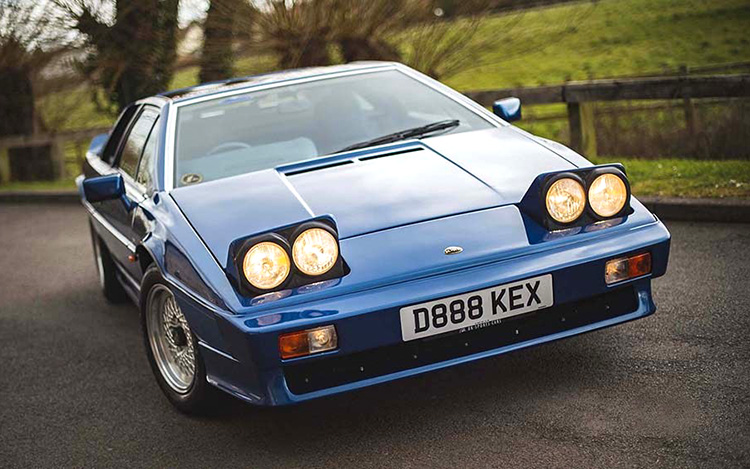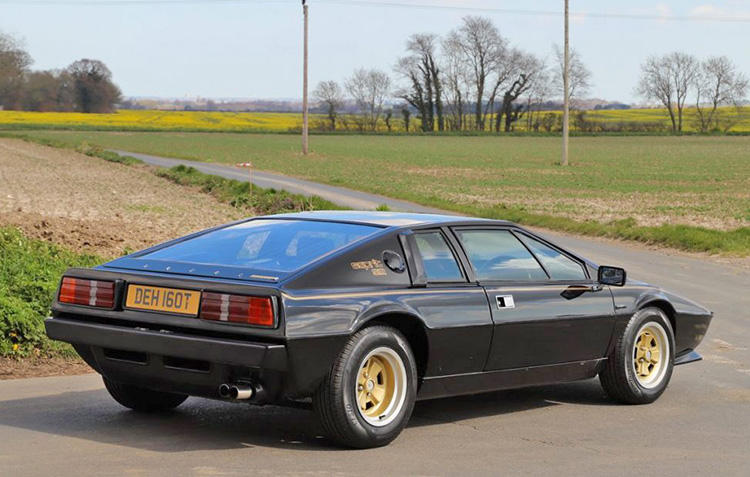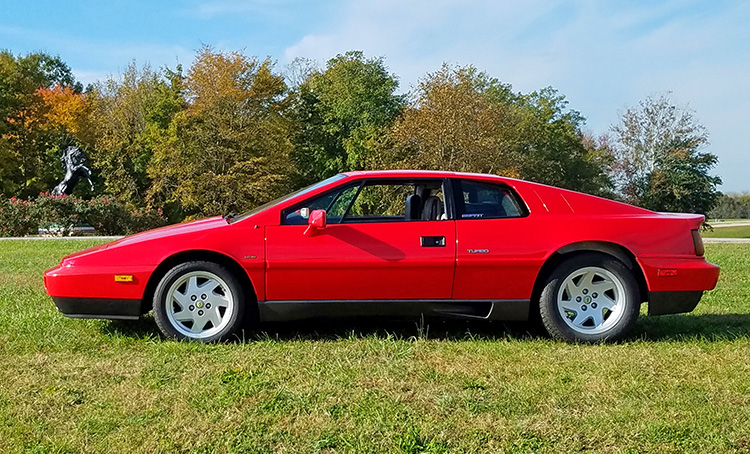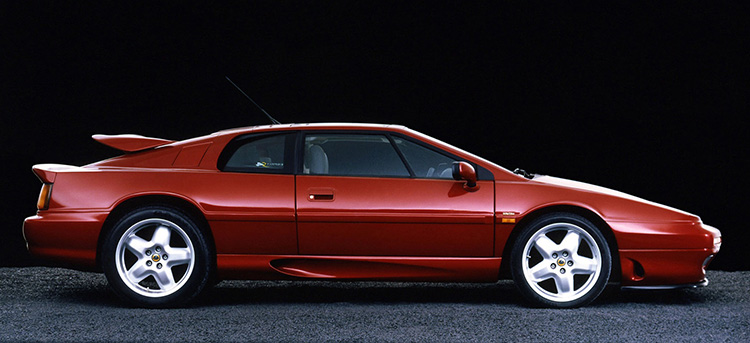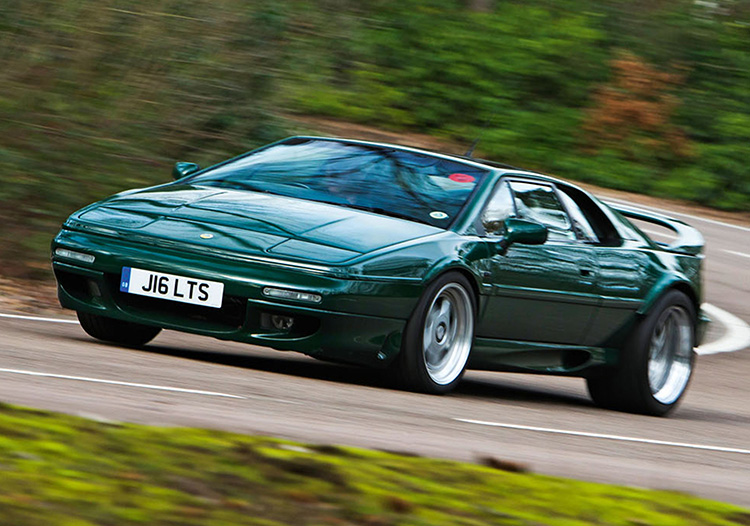
Supercar Legend
The Lotus budget was tight at the time, so it was decided that the more affordable front-engined car, which became the Elite, would take priority as it would account for more sales. Meanwhile, the Europa continued, upgraded with a new version of the 1558cc, 105bhp Lotus-Ford twin-cam engine to replace the S2-series' 82bhp 1470cc Renault unit.
The final Europa Special models had the 126bhp 'Big Valve' version of the twin-cam engine, and a five-speed gearbox - which might not sound particularly exciting until you consider its top speed of 125mph and a 0-60mph sprint of 6.5 seconds. But improving performance in the new car was not as vital as shaping up the Europa's cramped two-seater cabin and doubtful styling.
Lotus boss Colin Chapman entrusted the design of M70 to Giorgetto Giugiaro, who had already built up an impressive CV with his work at Fiat, Bertone and Ghia before starting his own studio, ItalDesign, in 1968. Chapman dubbed the project a special-bodied Europa at that stage.
But the silver prototype car unveiled on the ItalDesign stand at the 1972 Turin Motor Show was still described as a styling exercise, although it was already called 'Esprit', and it was known that the new car would receive Lotus' much-hyped Type 907 engine.
It was built on a lengthened, widened version of the Europa's steel backbone chassis, with a longer wheelbase. Giugiaro had already unveiled a mid-engined, wedge-shaped performance coupé that year, the Maserati Boomerang. Based on the chassis of the Bora, which Giugiaro had also designed, it indicated the direction his styling was taking, and effectively set the template for the Esprit.
The final design for M70 was signed off in the latter half of 1973; some details of the Europa-based prototype were not to make it to production, such as the twin windscreen wipers, 19-degree acute rake of the windscreen, louvres behind the nose panel and opening action of the rear liftgate, but many features remained.

The Conception
Lotus first started developing the Type 907 engine dated in 1966, when it decided to produce its own two-litre engine, easing its dependency on Ford to supply its twin-cam powerplant. Lotus signed up Coventry Climax engineer Ron Burr, who had been working on a four-valves-per-cylinder engine, and the template was drawn up for a slant-four unit that would form the basis of a whole new family of engines.
The engine had twin overhead camshafts, an aluminium alloy head and block and could crank out 150bhp. Its slant-four design meant that it could fit under flat bonnets, or that it could be doubled-up to make a V8. Lotus worked with Vauxhall, who were also working on a cast-iron engine of similar design. The first 2.0-litre race engines, called Type 904, ran in the Lotus 62 race cars. And after a few final trials, the production engine was ready.
However, the Europa and Elan were both too small to accommodate the new engine, and the M50/M70 programme had not yet got off the ground. This prompted Chapman to sign a deal in 1971 with new owner of Jensen, Kjell Qvale, to supply the Type 907 road-car engine, fitted with twin Dellorto or, in the US, Zenith Stromberg carburettors, for the Jensen-Healey.
In this model, the engine developed 140bhp, but there were problems with the oil flow back to the pumps. The wily Chapman persuaded a rather naïve Qvale to buy the engines without a warranty, saving Jensen far less money than this unreliable engine cost it in warranty claims. But most of the engine's troubles were ironed out in time for the launch of Lotus' Elite, which had larger Dellortos and produced 155bhp.
The 904 engine had always been destined for a mid-engined car, however, and a 160bhp version was developed for the Esprit. Its shape and installation meant a slight weight bias towards the left-hand side of the car, but this was not found to affect the handling.
As the Renault five-speed transaxle transmission used in the Europa could not handle such power and torque, Lotus sourced one from Citroën - the five-speed gearbox used in both Citroën's SM coupé and the mid-engined Maserati Merak. The Esprit's front suspension layout was derived from the Opel Ascona, servo-less disc brakes were sourced from Girling and 14-inch wheels from Wolfrace.
Other bought-in components included, famously, Morris Marina exterior door handles.The first production prototype was driven to Heathrow airport in January 1975 to meet Chapman on his return from the Argentine Grand Prix.
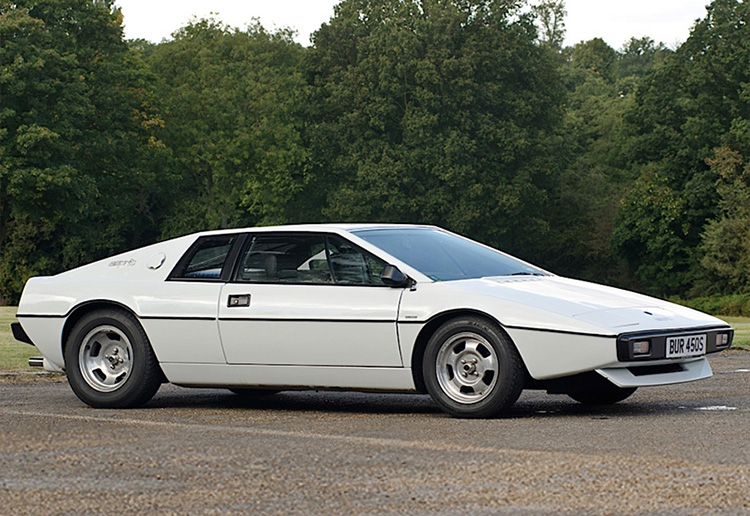
Esprit S1
The world oil crisis and recession of the early '70s again put Lotus into financial difficulties, delaying the Esprit's launch by some nine months. Even when it was formally announced in October 1975, it was still not ready for production.
But Lotus had to keep up interest amongst its clients, who were wondering if the M70 would ever see the light of day, and it wanted to unveil it alongside the Eclat, a 2+2 version of the front-engined Elite. The first deliveries to customers began in June 1976.
At that point, the price had to be raised to £7,885 from the
original £5,845 price tag, causing some ill-feeling towards
the car amongst the press. Road testers were quick to note that although
it had a larger cabin than the Europa, it was not much more practical,
with no luggage space apart from a small compartment in the facia,
and awkward access to the seats.
More damaging, a press car failed to live up to Lotus' performance claims in an Autocar test, and the cars were criticised for a lack of refinement and harsh-sounding engines. It was generally thought that the development programme was incomplete, an impression borne out by early problems with unreliability.
All the glitches were quickly forgotten when the Esprit's handling continued to live up to expectations, though, and it made a huge impact in the James Bond film 'The Spy Who Loved Me', mocked up as an amphibious vehicle. This clever piece of product placement ensured that its American launch was successful, and led to the sale of 580 Esprits in 1977 - a record never surpassed. Lotus did, however, speed up the launch of the Series 2 in response to the original criticisms.
S2 and DeLorean
The Esprit S2 hit the roads in August 1978, with more mid-range punch, a different camshaft (also fitted to some late S1s), and performance that met the original claims: Autocar measured 130mph and a sprint time of eight seconds.
The cabin evolved slightly, with wider, more sculpted seats, new instruments and switchgear and a digital clock, but the bodywork stood out with a more smoothly integrated front spoiler, redesigned air intakes behind the rear quarter-light windows, Speedline alloy wheels and Esprit decals. Spot the new taillights, too, as also seen on the rear of the Rover SD1. It also had a new motor mechanism for its pop-up headlamps, and a space-saver spare wheel under the bonnet.
The first owners of S2 Esprits were the two Team Lotus drivers, Mario Andretti and Ronnie Peterson, and the publicity team sought to gloss over the fact that inflation had forced the price of the S2 up to £11,125. The 1978 Birmingham Motor Show saw the launch of the 'Limited Edition' models, finished in the black and gold JPS livery to celebrate Andretti's success in the Formula One World Championships. One hundred were made, with individually numbered plaques on their dashboards, signed by Colin Chapman.
An interesting footnote to this period at Lotus was its involvement with DeLorean. The composite-bodied DeLorean coupé (also styled by Giugiaro) shared many chassis and suspension design principles with the Esprit, even though it was rear-engined, as Lotus played a significant role in the development work of this ill-fated model.
Given 18 months to make a severely flawed Renault V6-engined prototype ready for production, the project ended up taking over two years, at the expense of Lotus' own product development. The end result was a car compromised by its rear-engined layout, the construction techniques necessary to fit its gullwing doors, less than searing performance and high price: DeLorean went bankrupt, having pocketed millions of pounds from the British Government for the building of its factory in Northern Ireland.
Lotus, however, was praised for having done an excellent job under the circumstances. But Chapman's involvement in the project sullied his reputation - he was thought to have benefited from the missing millions, some considering the fatal heart attack he had not long after the DeLorean affair to be suspiciously convenient. For years after his death, many wondered whether he had spirited himself to Brazil to avoid the law.
S2.2
Lotus's
then Grand Prix sponsors, Essex Petroleum, threw a party at the Albert
Hall in late 1979, at which three prototype Esprits were displayed.
These had turbocharged 2.2-litre engines, which rather detracted from
the fact that normally aspirated versions of the same new engine had
already gone into production. The non-turbo Esprit S2.2 made its public
debut in March 1980, with a new version of the Type 907 engine dubbed
Type 912.
Its introduction had been delayed by the demands of the DeLorean project, but producing the engine for Chrysler Europe made the development possible for Lotus' own models. Enlarged to 2174cc, the engine was first fitted in the rally team Talbot Sunbeam-Lotus in 1979.
The car went on to win the 1980 RAC Rally and the 1981 Argentine Rally, as well as taking second place in Monte Carlo, Portugal, Corsica, Brazil and San Remo. In production form for the Esprit, the engine churned up 140lb ft of torque at just 2400rpm, although peak power remained at 160bhp. The Esprit S2.2 also boasted another significant improvement: a galvanised chassis frame.
This allowed Lotus to offer a five-year anti-corrosion warranty, necessary if the car was to sell in the States. Otherwise, it remained unchanged, apart from the badging and a new part-stainless-steel exhaust system. Prices rose to £14,950.
Turbo blows in... finally
The more eagerly awaited model came close behind the S2.2 in September 1980 - the Esprit Turbo. Officially, that is: Lotus dealers Bell & Colvill had been offering their aftermarket S2 conversion with bolt-on Garrett turbocharger since 1978, to meet customer demand for a faster Esprit as Lotus' development programme got pushed backwards.
The Bell & Colvill car produced 210bhp and 202lb ft of torque, accelerated from 0-60mph in 6.2 seconds, topped out at 150mph, and was generally more brutal than the later factory car. Lotus' own Turbo received more than a few engine mods, plus a new chassis, new rear suspension and more aerodynamic styling.
It had almost identical power figures to the Bell & Corvill car, leading some commentators to suggest that Lotus had benefited from the dealership's experiences. But substantial work had clearly been done by Lotus: the entire block was revised, receiving dry-sump oil lubrication used in many high-performance marques such as Porsche, air supply to the carbs boosted, the compression ratio reduced and the camshaft modified.
The end result was surprising refinement, smooth power delivery and lack of turbo lag. Motor's road testers recorded a top speed of over 140mph and 0-60mph in 5.6 seconds.The Esprit Turbo (codenamed M72) had its backbone-style chassis frame redesigned for a more rigid structure and to accommodate its new rear suspension system. It also had a wider engine bay to allow for the possibility of fitting a larger V8 engine - a long-running but as-yet unrealised aspiration. Giugiaro freshened up the styling, including adding a deep front airdam spoiler and larger front bumper, aerodynamic side skirts, and extra cooling ducts for the engine compartment.
The cabin benefited from new seats and upholstery, and the initially launched special-edition Essex Commemorative models (£20,950) had air conditioning and an FM radio, as well as distinctive but somewhat lurid livery and decals. Once the 100 Essex cars were sold, plain-painted Esprit Turbos were offered at £16,920, without the standard air-con or audio system. Demand for this model picked up, reaching a peak of 205 in 1982, helped by the car's appearance in the latest James Bond film, 'For Your Eyes Only'.The growing stringency of American emissions regulations then led to the development of two new versions of the Turbo in 1986: the HCPI, for sale in markets such as the US, and the 'rest-of-the-world' HC.
The
HCPI - High Compression, Petrol Injection - was the first Lotus to
feature fuel injection, a Bosch K-Jetronic system, and a catalytic
converter. It also had a raised compression ratio and boost pressure.
Wider, lower seats, and a bigger footwell added cabin comfort while
wider tyres were fitted along with a new front spoiler.
The 'rest of the world', including the UK, got the High Compression
version, which had the same high-compression head but retained the
carburettors. It also gained the new seats and, like the normally
aspirated (now S3) cars, an enlarged exhaust and improved cooling
system. It cost £24,980, boasted 215bhp and 20lb ft more torque,
and was an attempt to buoy interest in the now-dated range until the
heavily revised X180-series Esprit was ready for launch in autumn
1987.
S3 and Etna
Following the launch of the Esprit Turbo, the continuing normally aspirated cars were revised in spring 1981. These cost £13,460 - £1800 less than the outgoing S2.2 models, and usefully cheaper than the Turbos - and gained the new chassis, suspension and brakes as fitted to the Turbo.
Turbo-style alloys were optional, but Lotus is said to have stood firm against requests to kit out non-turbo S3 models with the spoilers and body kit. The new air intakes and larger bumpers were fitted, though, and inside, the cabin was updated slightly and soundproofing improved. Demand picked up, stimulated by the reduced entry-level price, though this began to tail off towards the mid-'80s as Lotus hit another series of financial setbacks in the aftermath of Colin Chapman's sudden death in December 1982.
New ownership for the firm was split between Chapman's family, who retained 20 percent, investors British Car Auctions (BCA) who took the controlling stake and Toyota, who took 16.5 percent; BCA man David Wickins was elected chairman. Construction company JCB then took an 11 percent stake in 1984, and Toyota upped its share to 20 percent.
However, by 1986, Lotus realised that it could not afford to build the new Elan, the necessary entry-level model the company needed to survive, and General Motors bought it out in January 1986.Against this backdrop - and the continuing repercussions of the DeLorean scandal - it is hardly surprising that Project M71, the V8-engined Esprit, never came to fruition.
It did come close, however: the 1984 Birmingham Motor Show brought the unveiling of Etna, a Giugiaro-designed prototype with Lotus's own 4.0-litre V8. This engine was effectively two of the slant-four units joined together and further modified, and in theory, Etna was said to be capable of over 180mph and 0-60mph in 4.3 seconds - it was hailed as a British Ferrari rival.
As well as an attempt to stimulate interest in an Esprit V8 and attract backers for such a project, Etna was also a showcase for Lotus' consultancy work; it had a crash-sensing radar system, a central computer controlling the engine management, active suspension settings, air conditioning and ABS, a computer-controlled continuously variable transmission and photo-sensitive glass - all very advanced stuff in 1984. But no backers for the project were found, and Etna was abandoned.
Under General Motors' ownership, development work on new models - including the M100 Elise - continued anew, but the Esprit S3 had to continue unchanged for a while. It still sold in small numbers in the UK, though the Americans preferred the Turbo. At the end of 1986, the non-turbo version of the High Compression engine, already fitted in the Excel, was launched, giving 172bhp and 163lb ft of torque. Like the HC Turbo, Esprit HC models had a slightly revamped cabin and other minor modifications including the lift-out roof panels; they were priced from £18,980, but now looked way behind the times.
X180 - the Esprit reborn
The
design for the heavily revised Esprit, launched in October 1987, was
the work of Peter Stevens, whose involvement in the project pre-dated
the GM takeover.
He had already styled the Excel, which replaced the Eclat, and his
team - which included the young Julian Thomson, now chief of advanced
design at Jaguar - softened Giugiaro's '70s wedge shape and angular
lines, bringing in subtle curves and modern styling cues.
Stevens kept the 'flying buttress' pillars, but introduced a see-through plexiglass panel on turbo models to improve all-round vision; although he made the windscreen glass more curved, the problems of reflection on the screen persisted. A more significant change was under the surface, though - the X180 Esprit was designed from scratch to be assembled using the VARI process, and the new structure was much stronger, more durable and cheaper to produce.
Despite this new structure, however, the chassis and suspension layout remained unchanged - meaning that no significant gains could be made in cabin space. Minor tweaks and new seats (tweed-leather replacing the ruched leather) gave a little more footroom, but most changes were superficial. Controversially, the buttons on the instrument binnacle were 'borrowed' from the Austin Maestro - and the Marina door handles were still there.
The new body structure meant that rigidity was increased, allowing Lotus to soften the suspension a little for greater ride comfort. Toyota supplied new brakes, and OZ alloys were fitted with Goodyear Eagle tyres. A new close-ratio five-speed manual gearbox was sourced from the Renault GTA/25 Turbo, too; this replaced the old Citroën SM set-up in Europe, though that continued in US-market cars for a while longer.
The engine was developed for a further 5bhp, and Car magazine achieved a 0-60 time of 5.3 seconds and a top speed of 158mph from the Turbo. The new car was thought to be a huge improvement, with out-and-out performance equalling that of rival Porsche and Ferrari models, though its throttle response and flexibility was considered inferior, as was its styling and build quality.
A limited-edition model celebrating Lotus' 40th anniversary, with white pearlescent bodywork, large rear spoiler and front air dam, two-tone blue leather/suede interior and CD player, was a hit at the 1988 Birmingham Motor Show, and sold well. In 1989 fuel injection was finally introduced across the range, a multi-point system provided by GM subsidiary AC Delco, with advanced microelectronics and engine management. But the May launch of the Esprit Turbo SE was the turning point for the range.
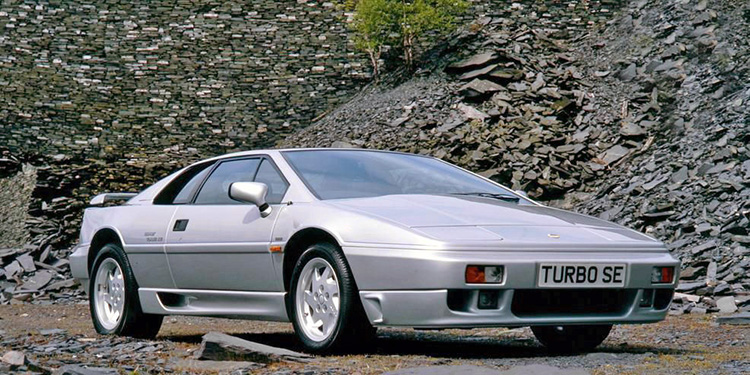
Turbo SE - a supercar at last
The Esprit Turbo SE was Lotus' first version that could credibly call itself a supercar. With the engine tuned to produce 264bhp, 60mph was possible in 4.7 seconds and it would reach a top speed of 164mph.
New forged pistons, a new induction system and exhaust with catalytic converter, a charge air-cooler, direct ignition system and new Delco engine management made it all possible. The fuel injection breathed new life into the old four-cylinder unit, now the most powerful 16-valve engine in the world. It also received slightly modified suspension, with stiffer front springs and revised geometry, plus gas-filled rear dampers and lightened steering.
4car's editor Richard Bremner, then deputy editor of Car magazine, wrote: "It now has the horsepower and performance not merely to stand comparison with Porsche 911s and Ferrari 328s, but to embarrass them, too." Editor Gavin Green commented on the improved quality of this model saying that "panel gaps were more even, the interior was tidier.
Lotus is still not in the Porsche or Ferrari class of car-building, but the gap is narrowing. After 14 years, the well-built Esprit is now a reality". More enthusiastic about the car's handling and speed, he concluded: "In its newly-fettled SE guise, there's no doubt that the Lotus is Britain's best supercar. It's not just Britain's best: it's one of the world's best, and without doubt, the world's best value. Lotus, second-division sports-car player to the Germans and the Italians for too long, is now up there in the premier league. Its SE is not only the world's most accelerative production sports car, it's one of the world's most capable." All this, for £42,500 - £8,600 more than the standard Esprit Turbo, which remained in production, and £14,000 more than the non-turbo model.
However, Car was not so sympathetic a year later; the Turbo SE lagged behind badly in a four-car test against the Ferrari 348, Honda NSX and Porsche 911 Carrera 2, "comprehensively out-pointed by the rival trio", and it was later criticised because "the stunning performance of that blown 2.2 SE engine never matched the abilities of the chassis, a failing that served only to emphasise the car's deficiencies in other departments. In short, it embodied frustration on wheels".
The non-turbo model was dropped from the line-up in 1991, and Lotus embarked upon an ambitious motorsport programme. Its race engines of the early '90s included a 300bhp, 261lb ft unit for the America SCCA sports car challenge series, which had a revised cylinder head, recalibrated engine management, larger fuel injectors and increased charge-cooling, and a larger Garrett turbocharger.
This engine was fitted into a limited-edition production car, the Esprit Sport 300, launched at the Birmingham Motor Show of 1992. Two Sport 300s raced in the 1993 Le Mans 24 Hours, the first Lotus-supported entry for over 30 years, but were unplaced.
S4 brings useful upgrades
By spring 1993, recession was biting and Lotus had just killed off both the aged Excel and the short-lived M100 Elan. That left just one model range in production: the Esprit. The confusingly-named S4-series was launched in the spring of that year, and Car noted that "if no-one wants the Esprit, then the unmentionable must be mentioned - Lotus will cease to be a car maker."
Good job, then, that the exterior facelift was sympathetic, with a subtler spoiler, and a new bonnet, light clusters, bumpers and side sills. The doors opened wider with new handles, addressing the criticisms that access was difficult.
Cabin improvement, including carbon-fibre trim, new instruments and switchgear (much lifted from the Vauxhall parts bin) and a new Nardi steering wheel all transformed the Esprit. Radical developments under the surface, too - power steering for the first time, new front suspension geometry and anti-roll bar, springs and dampers, revised rear coils and shock absorbers, and new 17-inch, five-spoke alloy wheels with fat Goodyear Eagle tyres.
The venerable engine remained the same, however, and still put out 264bhp - it was considered that this was still sufficient, though the engine management was tweaked for more low-down torque.
Car tested the S4 - now £47,000 - against a Ferrari costing £74,000, and had to conclude that the Ferrari was worth the extra cash. "The Lotus changes direction with just the sort of aplomb you'd hope for", wrote Bremner in the April 1993 issue of Car, but he pulled it up for its poorly packaged cabin, build quality glitches and niggles such as a "pathetic" windscreen wiper, lack of feel from the brakes, close-set pedals and, more annoying, driveline shunt that made it very difficult to drive smoothly.
It "is not as finished as it should be after so long", he complained, though he did judge it "the better driver's car... it offers a more tactile experience than the Ferrari where it counts - in the chassis department". And he concluded that, whilst the Ferrari still won out, "the great news is that this old, old car competes again. It looks like a supercar, it goes like a supercar and it handles like one."
The magazine's front cover declared it "the new Lotus that's more fun than a Ferrari", despite the criticisms. Yes, the Esprit had a new lease of life, and 1994 saw an 11 percent increase in sales, though Lotus itself was in trouble again: just 10 days after the S4's launch, the news broke that the company was up for sale, as GM sought to stem its losses and concentrate on its mainstream brands.
Lotus' ownership fell to Bugatti, headed by Italian investor Romano Artioli, who had bought the rights to the defunct French marque in 1990. Artioli was particularly interested in Lotus' active suspension technology, and Bugatti paid a rumoured £30million for the company, whose debts had at least been written off by GM. The rights for the Elan and its production were eventually sold off separately to the growing Korean company, Kia.
Under Bugatti, work commenced on finally achieving one dream: making an Esprit V8.In the meantime, the Esprit S4s was launched in November 1994, with the Sport 300's 300bhp engine, alloys, uprated brakes and body kit, but cabin and suspension as per the standard S4.
V8 power - not before time
The Bugatti buy-out didn't last long; by 1996, the company was bankrupt and Artioli surrendered the rights to the Bugatti brand to Volkswagen. Lotus was sold to Proton, then getting a foothold in the European market and keen to start making some proper modern, sporty cars, though Artioli stayed on till '98 as a Special Projects director. Just prior to the takeover - and a factor convincing the Malaysians that Lotus had a future - was the unveiling of the Esprit V8 at the Geneva Motor Show.
The new Type 918 3.5-litre twin-turbo engine produced 350bhp, 0-60mph acceleration in 4.5 seconds and a top speed of 171mph: the press loved it, declaring it the best Esprit yet, but had to conclude that its refinement, cabin quality and general sophistication was well behind that of its rivals.
It lost out to the contemporary Porsche 911 Carrera and Ferrari F355 in a Car group test, and although it was thought to still look fresh, the age of its basic chassis and cabin structure was really showing through. The Americans didn't mind, though: by now, the vast bulk of Esprit sales were Stateside, and the Esprit, with its large rear wing, OZ alloys, larger front air intakes and wheel arch extensions, removable glass roof and aluminium-trimmed cabin, appealed to middle-aged boy racers and Europhiles wanting an alternative to the ubiquitous 911, but unable to afford the Ferrari.
Their fantasies were further fuelled by the car's appearance in the infamous Sharon Stone film 'Basic Instinct', though the cars were upstaged by Stone's famously revelatory scene. UK prices were from £58,750."It's a menacing-looking car", thought Car, "remarkably ageless for an eight-year old reskin of a 21-year old design", but "inside, its age is more obvious... it's a bit of a parts-bin trawl, done rather long ago." Although its gearshift was awkward, "the Esprit V8 is extremely quick where it matters, with a fabulous spread of urge right across the rev range. Turbo lag is minimal - a fraction of the four-pot Turbo's response time - and the boost build-up brisk but not bombastic."
Its steering was judged to be the quickest and most direct of the three cars, even if the gearbox, still the old Renault item, was "detracting from the enjoyment of a rather fine chassis".A racing version, the GT1, was unveiled at the Paul Ricard circuit prior to the 1996 GT series, stripped out to 900kg and fitted with six-speed transmission, F1-style aerodynamics and carbon brakes, but it retired early with a fractured exhaust in its first event.
Its best result was a second at Silverstone later in the year, and a more effective advertisement for the model was the non-competitive Esprit V8 PPG Pace Car, with black/gold translucent paint, which was shown off at various US tracks.

Final revisions
The Esprit V8 Mk 2 was shown in both Chicago and London in 1998, to a mixed reception. Its restyled cabin didn't have quite the overhaul it needed, but the improved gearbox and gear selector mechanism and new twin-plate clutch addressed many of the criticisms of the previous model.
Forty kilograms lighter than its predecessor, the philosophy had shifted back to producing a more focussed driver's car rather than a luxury grand tourer. Four-cylinder models continued too, in the form of an entry-level version, the GT3, which had an engine back to the capacity of 1973cc, albeit with 240bhp and 294lb ft of torque.
This model was priced at £39,450 at its launch in October 1996, when it replaced the S4 and S4s, and remained the affordable way into the range until it was dropped in 2000 - bear in mind that the cheapest V8, the GT, was just £50 short of £50,000, and the V8 SE, launched in October 1998 with a full leather interior and air conditioning, was £59,950.
The most expensive Esprit, however, was 1999's Sport 350 special edition - £65,000. This was 80kg lighter than the GT, with light magnesium alloy OZ wheels, a positively massive carbon-fibre rear spoiler and front splitter, uprated AP Racing brakes and tweaked engine management for improved low-gear torque, though it shared the standard cars' 350bhp V8. Just 50 were made.
The Sport 350's extra features were then grafted into the standard range for the final iteration for 2002, which also had a redesigned rear panel with round taillights, new high-backed sports seats, different four-spoke 'crystal titanium' OZ wheels and a revised exhaust.
Range might be stretching things too far: there was just the one model, the Esprit V8, costing £49,995. Lotus proclaimed the "increased flexibility" of the remapped ECU (0-60mph now happened in 4.4 seconds), and pointed to the more upmarket cabin, with two-tone leather seats embossed with a Lotus logo, and aluminium trim detailing.
The facelift was followed by the news that Lotus was scaling back production from the rate of around one Esprit a week. The company, struggling to bring the new Elise/Vauxhall VX220 to production, was instigating a cost-cutting programme and laying off staff, and the M250 project was also shelved.
However, demand for the latest Elise remains strong, and Lotus is re-introducing it in America, concentrating its efforts on this model. The company will build 140 Esprits this year to fulfil final orders, before reworking the Esprit production line to make the extra Elises.
It's no surprise that the decision has been made to kill the Esprit off - the only surprise is that it took so long. A 'new GT coupe' is currently under development.
Lotusespritturbo.com
